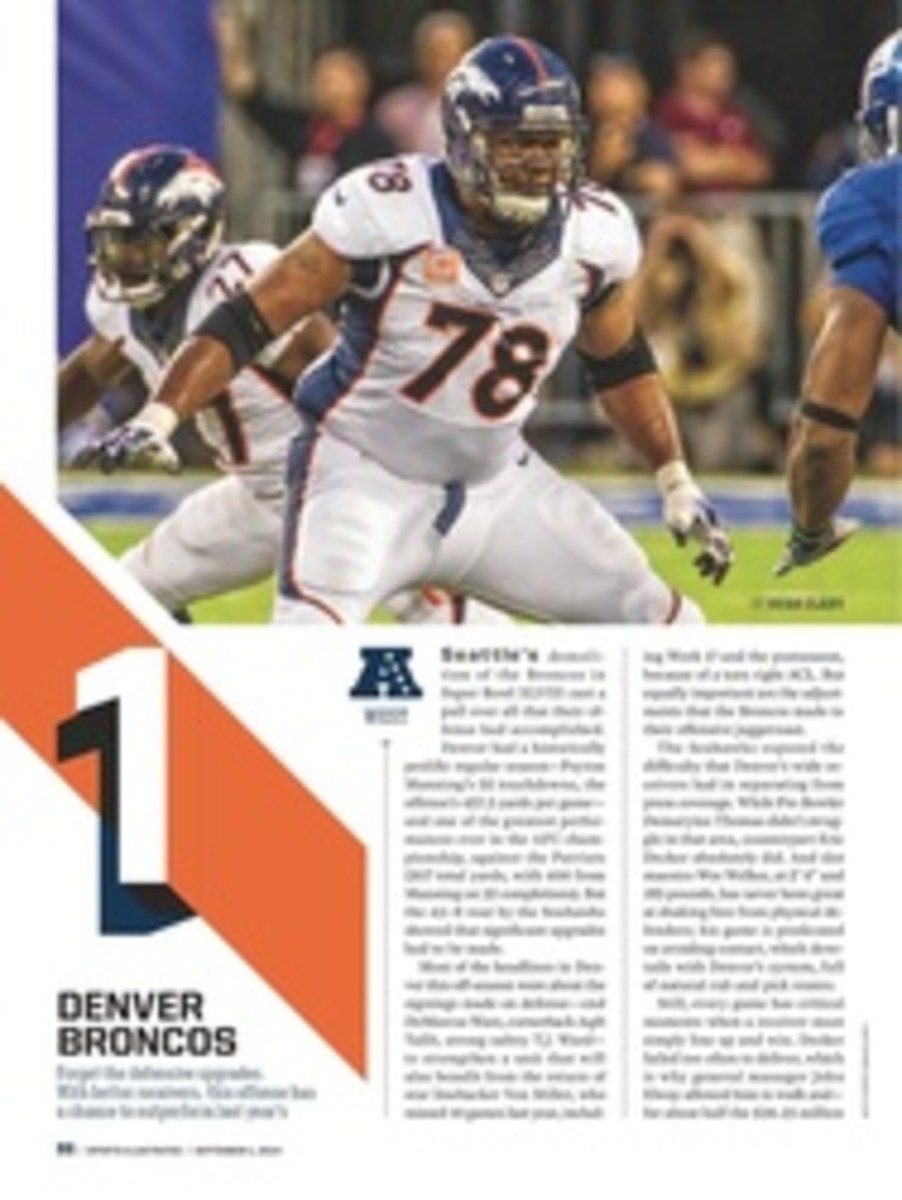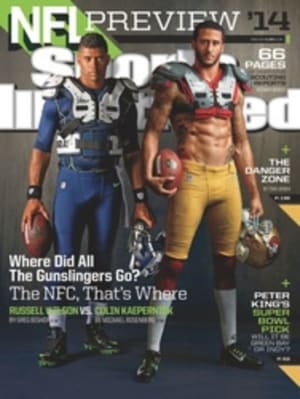
3 ATLANTA FALCONS
Think back to the NBA's Spurs of the mid-1990s, a team that was a perennial threat in the Western Conference playoffs. Then in the '96 preseason All-Star center David Robinson injured his back, and San Antonio face-planted, which turned out to be a blessing in disguise. Cast into the '97 draft lottery, the Spurs drew the No. 1 pick and came away with Tim Duncan. Suddenly they had two world-class big men—and, two years later, their first championship parade.
With good reason, Falcons fans hope to see the football version of this in 2014. Like those Spurs, this organization has been very competitive for most of the past six years, triggered by the arrival of GM Thomas Dimitroff, coach Mike Smith and quarterback Matt Ryan. But very competitive can be another way of saying not great. There's a championship hump to get over.
Last season electric wide receiver Julio Jones broke a screw in his surgically repaired right foot and was lost after Week 5. Pro Bowl wideout Roddy White suffered throughout 2013 from ankle and hamstring problems. And a slew of other vital contributors, including left tackle Sam Baker (12 games, knee), running back Steven Jackson (four games, thigh) and linebackers Sean Weatherspoon (nine games, foot) and Kroy Biermann (14 games, Achilles), were shelved for significant time. The upshot: a 4--12 face-plant in Atlanta.
That descent earned a very competitive team the No. 6 pick, which Dimitroff used on Texas A&M offensive tackle Jake Matthews. And while a tackle alone can't quite do for an organization what Duncan did for the Spurs, the rookie should at least rectify some of the pass-blocking weaknesses that have long hindered Atlanta's offense. Give Ryan time to throw, and factor in the return to health of Jones and White, and you suddenly have a proper title-contending offense.
In coordinator Dirk Koetter's system the quarterback needs a clean pocket. Yes, Ryan's diagnostic acumen in the presnap phase lets him know where he's throwing almost immediately. But this only helps on quick, three-step timing passes. The Falcons have two incredibly talented wideouts, and Koetter—when he's not dipping into his rich bag of screen passes—builds shrewd deep-intermediate route combinations around them. His play designs can strain defenses that try to double-team a wideout, and punish those that don't. But these deeper routes require five- or even seven-step drop-backs. Ryan, a sound but not rocket-armed passer, needs functional space to step into those throws.
Matthews will help give him that—though new challenges were presented when Baker was lost for the year (patellar tendon) in the preseason. Matthews must immediately jump in on the left side, opposite the ponderous Lamar Holmes. Dimitroff and Smith had clear intentions of getting stronger by signing former Chiefs guard Jon Asamoah, who plays bigger than his listed weight of 305. He'll replace Peter Konz, a 2012 second-round bust who has been a sieve in pass protection.
This is a line built to just survive in the passing game and dictate between the numbers on the ground. That fits the downhill style of Jackson, who at 31 is still a battering ram but no longer a home run threat.
With question marks all over their defensive front seven, the Falcons know they'll need to win aerial shootouts. In addition to Jones and White, slot receiver Harry Douglas is very effective on crossing patterns. And while future Hall of Fame tight end Tony Gonzalez has retired, Levine Toilolo, a fourth-round pick in 2013, gives them a similar style of target. Like Gonzalez, the 6'8", 265-pound Toilolo doesn't have to get open to make catches.
With his two stallions back at receiver, Koetter can return to running a hurry-up offense out of balanced formations. If the Falcons align Jones and White opposite each other, they'll often have route designs that beat man coverage on one side and zone coverage on the other. All Ryan has to do is diagnose the defense and know which favorable matchup to exploit. Koetter is adept at anticipating an opponent's tendencies simply through his formation choices. Against more unpredictable defenses, he'll switch to an unbalanced three-by-one set, which, with two standout receivers, all but guarantees that the D will simplify its coverages.
If everything comes together, the Falcons are capable of getting over the same hump that the Spurs finally got over 15 years ago.
2014 SCHEDULE
2013 Record: 4--12
WEEK 1
NO [HOME]
CIN [AWAY]
TB THUR [HOME]
MIN [AWAY]
NYG [AWAY]
CHI [HOME]
BAL [AWAY]
DET LONDON
BYE
TB [AWAY]
CAR [AWAY]
CLE [HOME]
ARI [HOME]
GB MON [AWAY]
PIT [AWAY]
NO [AWAY]
CAR [HOME]
WEEK 17
FOCUS ON
Mike Nolan's bag of tricks
Just because Nolan, Atlanta's defensive coordinator, is altering his scheme, from a hybrid into more of a 3--4, that doesn't mean he'll throw away his myriad coverage rotations and blitz exchange concepts—that kind of trickery is how he built his reputation. The Falcons drafted two man-oriented cornerbacks last year (Desmond Trufant in round 1, Robert Alford in round 2) because they wanted more freedom in deciding how to deploy their safeties and how to manufacture a pass rush. Trufant is a star in the making, and Alford has shown serious upside. Nolan should have even more chicanery up his sleeve this year, and most of that will involve the safeties, his favorite interchangeable weapons. Atlanta spent a third-round pick in May on Dezmen Southward (Wisconsin), who the team hopes can adapt quickly and supplant stop-gap veteran free safety Dwight Lowery. Whichever one plays, he'll be joined by William Moore, one of football's fiercest downhill missiles. That combination in the secondary is something Nolan can build around.
THE CASE FOR
Defensive end Jonathan Babineaux
Babineaux is the best active veteran of five or more years never to have made a Pro Bowl. In fact, he's one of the league's best D-linemen, period. He brings a rare burst, a know-how for shedding blocks, the nimbleness to redirect in traffic and a second gear for closing in on targets. He flashes these traits all four quarters, every single week. You can add versatility to that list, too, as last season he moved from his longtime tackle position to strongside end without a hitch. That was great training for 2014. Wanting to get brawnier up front, coordinator Mike Nolan is switching from a hybrid 4--3 to a true 3--4. To make that work the Falcons signed free-agent nose Paul Soliai and drafted the risky but talented Ra'Shede Hageman (Minnesota) as an understudy. They also inked end Tyson Jackson, who played in a similar scheme with the Chiefs. Jackson and Babineaux will often align head-up on offensive tackles, leaving them to clog the gaps on both sides of those linemen. It's crucial that they dominate these battles; the Falcons lack experienced outside 'backers and are relying on undrafted second-year pros Joplo Bartu and Paul Worrilow inside. Overlooked though he may be, Babineaux is the type of guy who can make this new scheme work.
PHOTO
KEVIN C. COX/GETTY IMAGES
WR JULIO JONES
PHOTO
TOM DIPACE
NINTEEN PHOTOS

